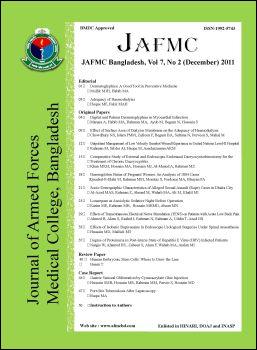Digital And Palmar Dermatoglyphics In Myocardial Infarction
DOI:
https://doi.org/10.3329/jafmc.v7i2.10386Keywords:
Dermatoglyphic pattern, susceptibility, myocardial infarction (MI)Abstract
Introduction: Dermatoglyphics pattern is feature with which human takes birth. As a diagnostic aid, it is now well established in a number of diseases which have a strong hereditary basis. The aetiology of coronary heart diseases is believed to be multi-factorial with genetics playing an important role.
Objective: The present study was designed to make an observation of the usefulness of dermatoglyphic pattern in serving as a predictor for myocardial infarction among Bangladeshi male who were non relative to each other.
Place of study: The study was conducted in the Department of Anatomy, Bangabandhu Sheikh Mujib Medical University (BSMMU), Dhaka, Bangladesh, between October 2003 and February 2005.
Method: Inking method was used for taking finger and palm prints. Dermatoglyphic prints of five fingers and palm of both hands of sixty individuals were collected. Of them dermatoglyphic prints of both hands of 30 myocardial infarction (MI) male patients non relative to each other were selected as patients and same of 30 normal male having no myocardial infarction and having no family history of MI were selected as control. The dermatoglyphics of each hand of the patients were compared with those of the controls for: a) frequencies of different finger ridge patterns of the five fingers; b) total finger ridge count (TFRC); c) a-b, b-c, and c-d ridge counts of each hand; d) a-t-d angle; e) frequency of palmar ridge pattern and f) frequencies of different palmar creases.
Result: The results of the controls confirmed more or less to the ethnic trends of the normal Bangladeshi. In case of finger dermatoglyphics, the MI patients showed higher frequencies of whorl patterns but lower frequencies of ulnar loop, radial loop and arch patterns than the controls. The mean total finger ridge count of the MI patients was lower than that of the controls (p>0.05). In case of palmar dermatoglyphics a-b, c-d ridge counts was higher and b-c ridge counts was lower in the MI patients than in the controls. Mean a-t-d angle was wider in the MI patients than that of the controls. Palmar patterns and creases showed no significant difference except transitional crease of the right hand that was significantly lower in MI patients than controls.
Conclusion: Result of this study may be used to standardize the dermatoglyphic pattern of Bangladeshi population and to identify person susceptible to MI.
DOI: http://dx.doi.org/10.3329/jafmc.v7i2.10386
JAFMC 2011; 7(2): 4-8
Downloads
226
466

